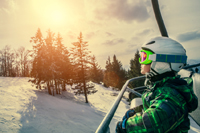 Mark A. Pollard, MD, Orthopaedic Surgeon
Mark A. Pollard, MD, Orthopaedic Surgeon
Cooper Bone & Joint Institute
Winter is a wonderful time of year that allows the opportunity to participate in fun activities like skiing, snowboarding, ice skating and sledding. Unfortunately, injuries frequently are an unintended consequence of these activities. More than 310,000 people were treated in hospitals, doctors’ offices and emergency rooms in 2012 for winter sports-related injuries, according to the U.S Consumer Product Safety Commission. Of these, more than 40,000 were caused by sledding, nearly 98,000 involved snowboarding, about 120,000 were skiing injuries and 53,000 involved ice skating. Many of these injuries may have been preventable.
Injuries that are common to winter sports include fractures, dislocations, sprains, strains or contusions (bruises). These injuries seem to be common at the end of the day, when the participant is tired. Recognizing when you are tired and stopping to rest may be one of the most important things one can do to prevent injuries from occurring—participating while exhausted isn’t a good idea.
Before an activity, many things can be done to prevent injury. Proper conditioning can prevent fatigue that can predispose to injury. Familiarity with the terrain and equipment is essential. With skiing or snowboarding, properly fitted equipment that is in good repair is also important. Helmet use can also help prevent devastating head injuries. Finally, a good warmup is a great way to prevent injury – cold muscles and tendons are more prone to injury than ones that have been properly warmed up.
Dehydration is common with winter sports and activity. When you become dehydrated, fatigue can set in easily, performance suffers and there is an increased risk for hypothermia. It is important to remember to drink plenty of water before, during and after participation in winter sports.
Finally, injuries due to cold weather deserve mention. Hypothermia and frostbite are common and, often, preventable. If you plan to be outdoors for extended periods, wear layers of warm clothing. Pay special attention to exposed skin especially ears, nose and fingers. Signs of frostbite include stinging, burning and numbness. You may experience pain, throbbing, burning or an electric current-like sensation when the affected area is re-warmed. In first-degree frostbite, the affected area of skin usually becomes white and feels numb. Sometimes the skin is red. Seek shelter and warmth immediately if you notice any of these conditions.
Winter is a great time to get outside and get some exercise. Common sense and proper preparation can minimize the chance of problems so you can maximize the fun.
